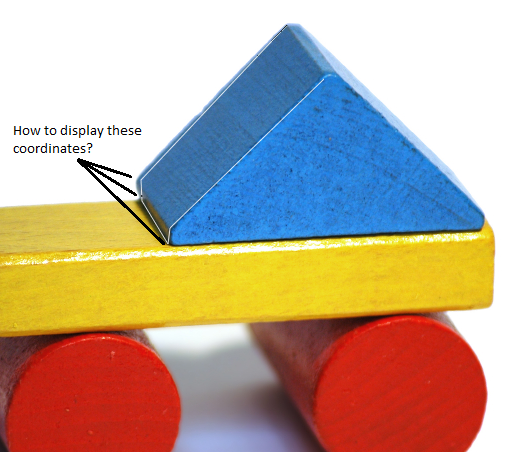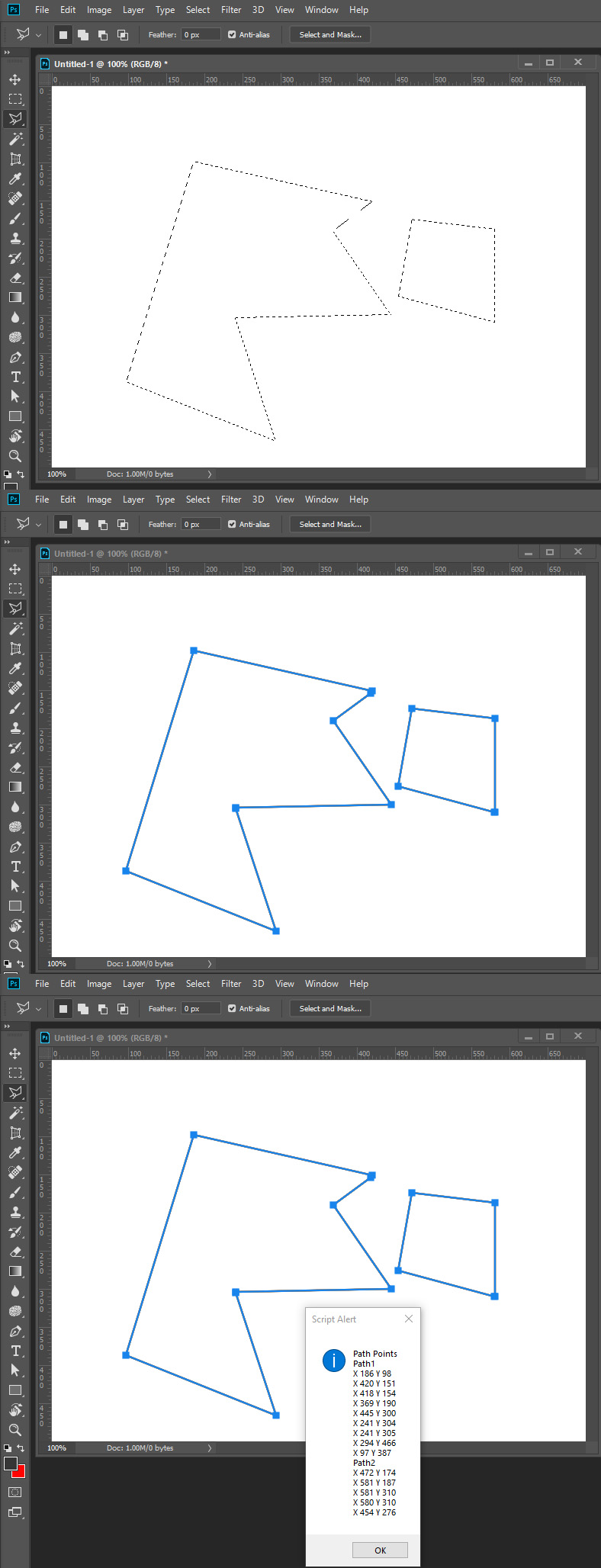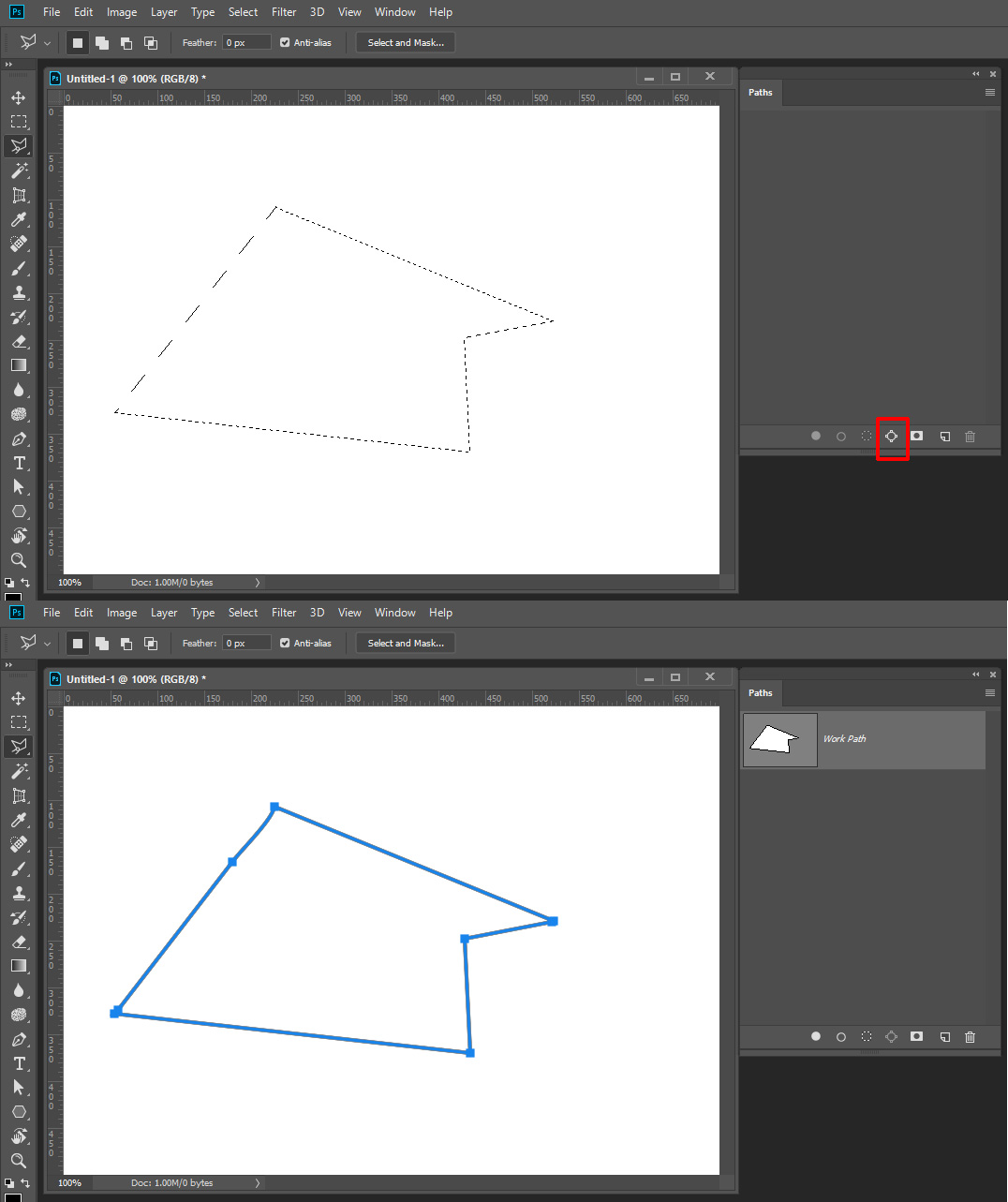 Adobe Community
Adobe Community
- Home
- Photoshop ecosystem
- Discussions
- How to display vertex coordinates of Polygonal Las...
- How to display vertex coordinates of Polygonal Las...
Copy link to clipboard
Copied
I use Polygonal Lasso Tool to form a selection like the screenshot below:

Now I want to record the accurate vertex coordinates of the Polygonal Lasso Tool. Do you know how to display these coordinates somewhere in Photoshop so that I can record them manually in a notebook or automatically as a file? Thanks a lot.
PS: I'm using Photoshop CC 2019 on Windows 10.
 1 Correct answer
1 Correct answer
The price is a bottle of red wine don't go overboard a $15 bottle will do.
...// enable double-clicking from Mac Finder or Windows Explorer
#target photoshop // this command only works in Photoshop CS2 and higher
// bring application forward for double-click events
app.bringToFront();
// Save the current preferences
var startRulerUnits = app.preferences.rulerUnits;
// Set Photoshop to use pixels
app.preferences.rulerUnits = Units.PIXELS;
var thePath = selectedPath();
if (thePath == undefined) {
alert("No
Explore related tutorials & articles
Copy link to clipboard
Copied
You may be able to write a Photoshop Script to do that. The script would have Photoshop convert the selection to a Path them process path to get the control points coordinates. There may be extra points the script could also write the path to a log file. Set guide line marking the points so you can read them on the rulers and switch between ruler unites just record the point you want in the unites you want. A path can have many points a list may not fit on your display.

Copy link to clipboard
Copied
@JJMack: Thank you. I have no knowledge of writing script in Photoshop and my time budget does not allow me to study it. Could you please share your script with me? I can pay you for the script.
Copy link to clipboard
Copied
hengz80545720 wrote
Do you have a lot or a few of these to do?
Would it work for you to:
- Convert your selection to a path in the Paths panel
- Open the Info panel
- Select an anchor point with the Direct Selection tool (white arrow)
- Copy the info from the X and Y


Copy link to clipboard
Copied
The price is a bottle of red wine don't go overboard a $15 bottle will do.
// enable double-clicking from Mac Finder or Windows Explorer
#target photoshop // this command only works in Photoshop CS2 and higher
// bring application forward for double-click events
app.bringToFront();
// Save the current preferences
var startRulerUnits = app.preferences.rulerUnits;
// Set Photoshop to use pixels
app.preferences.rulerUnits = Units.PIXELS;
var thePath = selectedPath();
if (thePath == undefined) {
alert("No Path Selected");
}
else {
var myPathInfo = extractSubPathInfo(thePath);
var pathPoints = "Path Points\n"
for(var k=0;k<myPathInfo.length;k++){
pathPoints = pathPoints + "Path" + (k+1) + "\n";
for(var j=0;j<myPathInfo
.entireSubPath.length;j++){ pathPoints = pathPoints + "X " + myPathInfo
.entireSubPath .anchor[0] + " Y " + myPathInfo .entireSubPath .anchor[1] +"\n"; MarkX(myPathInfo
.entireSubPath .anchor[0]); MarkY(myPathInfo
.entireSubPath .anchor[1]); }
}
alert(pathPoints);
}
////// determine selected path //////
function selectedPath () {
try {
var ref = new ActionReference();
ref.putEnumerated( charIDToTypeID("Path"), charIDToTypeID("Ordn"), charIDToTypeID("Trgt") );
var desc = executeActionGet(ref);
var theName = desc.getString(charIDToTypeID("PthN"));
return app.activeDocument.pathItems.getByName(theName)
}
catch (e) {
return undefined
}
};
// Return the app preferences
app.preferences.rulerUnits = startRulerUnits;
////// michael l hale’s code //////
function extractSubPathInfo(pathObj){
var pathArray = new Array();// each element can be used as the second arugment in pathItems.add ie doc.pathItems.add("myPath1", [pathArray[0]]);
var pl = pathObj.subPathItems.length;
for(var s=0;s<pl;s++){
var pArray = new Array();
for(var i=0;i<pathObj.subPathItems
.pathPoints.length;i++){pArray = new PathPointInfo;
pArray.kind = pathObj.subPathItems
.pathPoints.kind;pArray.anchor = pathObj.subPathItems
.pathPoints.anchor;//alert("Anchor " + pathObj.subPathItems
.pathPoints.anchor );pArray.leftDirection = pathObj.subPathItems
.pathPoints.leftDirection;pArray.rightDirection = pathObj.subPathItems
.pathPoints.rightDirection;};
pathArray[pathArray.length] = new Array();
pathArray[pathArray.length - 1] = new SubPathInfo();
pathArray[pathArray.length - 1].operation = pathObj.subPathItems
.operation;pathArray[pathArray.length - 1].closed = pathObj.subPathItems
.closed;pathArray[pathArray.length - 1].entireSubPath = pArray;
};
return pathArray;
};
function MarkX(x) {
// =======================================================
var idMk = charIDToTypeID( "Mk " );
var desc61 = new ActionDescriptor();
var idNw = charIDToTypeID( "Nw " );
var desc62 = new ActionDescriptor();
var idPstn = charIDToTypeID( "Pstn" );
var idPxl = charIDToTypeID( "#Pxl" );
desc62.putUnitDouble( idPstn, idPxl, x);
var idOrnt = charIDToTypeID( "Ornt" );
var idOrnt = charIDToTypeID( "Ornt" );
var idVrtc = charIDToTypeID( "Vrtc" );
desc62.putEnumerated( idOrnt, idOrnt, idVrtc );
var idGd = charIDToTypeID( "Gd " );
desc61.putObject( idNw, idGd, desc62 );
executeAction( idMk, desc61, DialogModes.NO );
}
function MarkY(y) {
// =======================================================
var idMk = charIDToTypeID( "Mk " );
var desc63 = new ActionDescriptor();
var idNw = charIDToTypeID( "Nw " );
var desc64 = new ActionDescriptor();
var idPstn = charIDToTypeID( "Pstn" );
var idPxl = charIDToTypeID( "#Pxl" );
desc64.putUnitDouble( idPstn, idPxl, y );
var idOrnt = charIDToTypeID( "Ornt" );
var idOrnt = charIDToTypeID( "Ornt" );
var idHrzn = charIDToTypeID( "Hrzn" );
desc64.putEnumerated( idOrnt, idOrnt, idHrzn );
var idGd = charIDToTypeID( "Gd " );
desc63.putObject( idNw, idGd, desc64 );
executeAction( idMk, desc63, DialogModes.NO );
}
Copy link to clipboard
Copied
@JJMack: Thank you so much for the script. May I ask one more question: I saved the script into C:\Program Files\Adobe\Adobe Photoshop CC 2019\Presets\Scripts\ShowCoord.jsx. This script now shows up in menu File -> Scripts. Then I initiated the Polygon Lasso Tool and made a selection. But when I clicked the menu to run the script, I was given a message "No Path Selected". I tried to call the script via File -> Scripts -> Browse ... but got the same alert. I checked the script and found it is because line 12 returns undefined. I guess the script thought the selection is not selected (or activated), but it is indeed selected:

Could you please tell me how to use the script correctly? Thank you again.
Copy link to clipboard
Copied
Open the path panel and click on the icon in the bottom to convert the selection to a path the message states you have no path.

Copy link to clipboard
Copied
It is working now! I'm so grateful for your help. Thank you!!!
Copy link to clipboard
Copied
Send the red my way.
Copy link to clipboard
Copied
Is there updated code for this?

